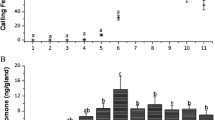Abstract
When molested, the marine opisthobranchNavanax inermis secretes into its slime trail, a bright yellow mixture of three major compounds and several closely related minor substances. Collectively, these compounds induce an avoidance-alarm response in a trail-followingNavanax at the concentration limits of 1 × 10−5 M. The three major compounds have been isolated and identified as 10-(3′-pyridyl)-3E,5E,7E,9E-decatetraen-2-one (navenone A), 10-phenyl-3E,5E,7E,9E-decatetraen-2-one (navenone B) and 10-(4′-hydroxyphenyl)-3E,5E,7E,9E-decatetraen-2-one (navenone C). The minor constituents of the mixture are proposed as the 3Z,5Z,7E,9E-isomers and the 3-methyl homologs of navenones A and B. The navenones appear to be produced in a specialized gland referred to in earlier studies as the “yellow gland” and to communicate the presence of predators within the species.
Similar content being viewed by others
References
Atema, J., andStenzler, D. 1977. Alarm substance of the marine mud snail,Nassarius obsoletus: Biological characterization and possible evolution.J. Chem. Ecol. 3:173–187.
Bertsch, H., andSmith, A.A. 1970. Observations on opisthobranchs of the Gulf of California.Veliger 13:171–174.
Blair, G.M., andScapy, R.R. 1972. Selective predation and prey location in the sea slugNavanax inermis.Veliger 15:119–124.
Von Frisch, K. 1941. Über einen Schreckstoff der Fischhaut und seine biologiche Bedeutung. Z.Vergl. Physiol 29:46–145.
Von Frisch, K. 1938. ZurdePsychologie des Fisch-schwarmes.Naturwissenschaften 26:601–606.
Gehlach, F.R., Watkins, J.F., and Kroll, J.C. 1971. Pheromone trail-following studies of Typhlopid, Leptotyhopid, and Colubrid snakes.Behavior 40:282–294.
Grant, P.T., andMackie, A.M. 1974.Chemoreception in Marine Organisms, 254 pages. Academic Press, New York.
Howe, N.R., andSheikh, Y.M. 1975. Anthopleurine, a sea anemone alarm pheromone.Science 189:386–388.
Karlson, P., andButenandt, A. 1959. Pheromones (Ectohormones) in insects.Annu. Rev. Entomol. 4:39–58.
Kittredge, J.S., Takahashi, F.T., Lindsey, J., andLasker, R. 1974. Chemical signals in the sea: Marine allelochemics and evolution.Fish. Bull. 72:1–11.
Murray, M.J., andLewis, E.R. 1974. Sensory control of prey capture inNavanax inermis.Veliger 17:156–158.
Paine, R.T. 1965. Natural history, limiting factors and energetics of the opisthobranchNavanax inermis.Ecology 46:603–691.
Paine, R.T. 1963. Food recognition and predation on opisthobranchs byNavanax inermis.Veliger 6:1–9.
Pasto, D.J., andJohnson, C.R. 1969.Organic Structure Determination, page 106. Prentice Hall, Englewood Cliffs, New Jersey.
Rudman, W.B. 1974. A comparison ofChelidonura, Navanax, andAglaja with other genera of the Aglajidae (Opisthobranchia; Gastropoda).Zool. J. Linn. Soc. 54:185–212.
Scheuer, P.J. 1977. Chemical communication of marine invertebrates.BioScience 27:664–668.
Sleeper, H.L., andFenical, W. 1977. Navenones A-C; trail-breaking alarm pheromones from the marine opisthobranchNavanax inermis.J. Am. Chem. Soc. 99:2367–2368.
Stenzler, D., andAtema, J. 1977. Alarm response of the marine mud snail,Nassarius obsoletus: Specificity and behavioral priorityJ. Chem. Ecol. 3:159–171.
Thompson, T.E. 1960. Defensive adaptations in opisthobranchs.J. Mar. Biol. Assoc. U.K. 39:123–134.
Wadell, W.H., Crouch, R., Nakanishi, K., andTurro, N.J. 1976. Quantitative aspects of the photochemistry of isomeric retinals and visual pigments.J. Am. Chem. Soc. 98:4189–4192.
Wheeler, J.W. 1976. Insect and mammalian pheromones.Lloydia 39:53–59.
Wilson, E.O. 1970. Chemical communication within animal species, pages 133–155, E. Sondheimer and J.B. Simeone, (eds.).Chemical Ecology. Academic Press, London.
Author information
Authors and Affiliations
Rights and permissions
About this article
Cite this article
Sleeper, H.L., Paul, V.J. & Fenical, W. Alarm pheromones from the marine opisthobranchNavanax inermis . J Chem Ecol 6, 57–70 (1980). https://doi.org/10.1007/BF00987527
Received:
Revised:
Issue Date:
DOI: https://doi.org/10.1007/BF00987527




